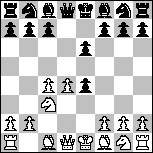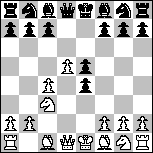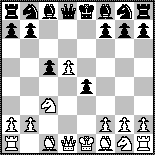DDG
4.Nc3 and Various
Outside the main lines, Black has a couple of interesting options
after 1.e4 e6 2.d4 d5 3.c4 dxe4 4.Nc3.
Especially 4...e5 is a fascinating move.
B

|
- 4...Nc6
- 4...e5 (Pietilš Variation)
- 4...c5 (Tarrasch Defence)
- 4...Be7 (Charousek Variation)
- 4...c6 transposes
- 4...Various
|
I have met this strong-looking move only a few times. It often
transposes to more common variations, but the following moves may also
lead to unique lines.
- 5.Be3 f5 (5...Nf6 transposes)
6.f3 Nf6 7.fxe4?? Ng4 8.Bf4 Qxd4 9.Qxd4 Nxd4 10.Rd1 Bc5 0-1,
Vandenbroucke - Hassim, DDGA
1996.
- 5.d5 exd5 6.cxd5
- 6...Nb4 7.a3
(7.f3 c6 8.fxe4 cxd5 9.a3 Nc6 10.exd5 Ne5 =,
Heikkinen - Laine, 1990,
while 7...Nf6 transposes)
7...Nd3+ 8.Bxd3 exd3 9.Qxd3 Nf6 10.Bf4 Bd6 11.Nge2 O-O 12.O-O
Bg4 13.Rfe1 Qd7 14.Bxd6 Qxd6 15.Qg3 Qxg3 16.Nxg3 Rfe8, draw in 38,
Brause - jonh, FICS 1996.
- 6...Nce7 7.Qa4+ Bd7 8.Qxe4 Nf6 9.Qe5 Ng4 10.Qd4 h5 11.Bf4
Nf6 12.Bc4 a6 13.Qe5 b5 14.Bb3 b4 15.Ne4 Nxe4 16.Qxe4 a5 17.Qc4
Nf5 18.d6 Nxd6 19.Bxd6, 1-0 in 50, Brause - ratelaar, FICS 1996.
- 5.f3 Qxd4 6.Bd2? Bc5 (6...e3!) 7.Qe2 Nb4 8.O-O-O Nd3+ 9.Kb1
Nf2 10.Nb5 Qd3+ 11.Qxd3 exd3 12.Nxc7+ Ke7 13.Nxa8 Nxh1, 1-0 in 29,
Bronstring - van Dijk, 1994.
- 5.Nge2 f5!
(5...Nf6 transposes)
6.Be3 e5 7.d5 Nce7 8.Bg5 Bd7 9.Ng3 h6 -/+,
Heikkinen - Rebel Decade, 1995.
4...e5 (Pietilš Variation)
4...e5!? looks paradoxical in that Black moves the e-pawn
for the second time. The move was invented by Jari Pietilš, a
colleague of mine.
The position resembles the BDG, Lemberg Defence, also known
as the Lemberg(er) Counter-Gambit, except that White has played
c4 for free. On the other hand, the c4 move has drawbacks: it takes
two potential squares from the king's bishop, and it would weaken
White's king after queenside castling.
The best way to utilize the c4-pawn is
5.d5.
B

Other moves that have been tried:
- 5.dxe5 Qxd1+ 6.Kxd1 f5 7.f3 exf3 8.Nxf3 c6 9.Bd3 Bb4 10.Ne2
Ne7 11.Kc2 O-O 12.a3 Ba5 13.Rd1 Re8 14.c5 Ng6 15.Bc4+ Kh8 16.Bf7
Re7 17.Bxg6 hxg6 18.Bg5 Re8 19.Nf4, draw in 74,
Laucius - Heikkinen,
Chessmaster
Online 1996.
This looks quite promising for White.
- 5.f3?! exd4 6.Nxe4 Nc6 7.Bd3 Bb4+ 8.Bd2 Qe7 9.Ne2 f5 10.N4g3
Qe3?! 11.Bxf5 Nge7 12.Bxc8 Rxc8,
Smith - Heikkinen, corr. 1996.
This was my very first DDG as Black!
A) 5...Bf5
- 6.Qb3 Na6 7.Be3 Bd6 8.Qxb7?! Nb4 9.O-O-O Rb8 10.Qxa7 Ra8
11.Qb7 Rb8 draw,
Heikkinen - Pietilš, 1996.
- 6.f3 exf3 7.Qxf3 Qd7 8.Be3 Bb4 9.Qg3 Bxc3+ 10.bxc3 f6
11.Nf3, draw in 30,
Heikkinen - Pietilš, 1996.
B) 5...f5 6.f3 Bc5 7.fxe4 Bxg1 8.Rxg1
- 8...fxe4 9.Qh5+ Kf8 10.Nxe4 Nf6 11.Qh4, 1-0 in 22,
Heikkinen - Pietilš, 1996.
- 8...Qh4+ 9.g3 Qxh2
- 10.Rg2 Qh1 11.Nb5 Na6 12.d6 Nf6 13.dxc7 O-O 14.Be3 Ng4 15.Qd5+ Kh8
16.Bc5 Nxc5 17.Qxc5 Bd7 18.O-O-O Bxb5 19.cxb5 fxe4 (19...Qh6+ 20.Kb1
Qe3 21.Qxf8+) 20.Qxf8+! (or 20.Rgd2) Rxf8 21.Rgd2 1-0,
Heikkinen - Pietilš, 1996
!.
- 10.Be3 Nf6 11.Bc5 Na6 12.Rg2 Qh1 13.Ba3 fxe4 14.Qa4+ Bd7 15.Nb5
Qh6 16.d6 c6 17.Nc7+ Nxc7 18.dxc7 Qe3+ 19.Be2 Qb6 20.Qb4 Qxc7??
21.Qe7# 1-0,
Heikkinen - Pietilš, 1996.
C) 5...Nf6 6.Bg5?! (6.Nge2) h6 7.Bxf6 Qxf6 8.Nxe4 Bb4+ 9.Nd2
O-O 10.a3 Bxd2+ 11.Qxd2 Rd8, 0-1 in 26, Heikkinen - Pietilš, corr.
2003-2004. The lesson learned is that White should retain the Queen's
Bishop, instead of trying to regain the pawn.
D) 5...Bb4?? 6.Qa4+ wins a piece.
The Ellis Gambit 1.e4 e6 2.d4 d5 3.Nc3 dxe4 4.Nxe4 e5
might also transpose to this line.
The following Lemberg Defence lines have ideas similar to this DDG
variation:
1.d4 d5 2.e4 dxe4 3.Nc3 e5
- 4.dxe5 Qxd1+ 5.Nxd1 Nc6 6.Bf4 Nge7 7.Bb5 Bd7 8.Nc3 Ng6
9.Nge2 Nxf4 10.Nxf4 Nxe5 11.Bxd7+ Nxd7 12.Nxe4 is an analysis by
von Popiel.
- 4.Nge2 exd4 5.Qxd4 Qxd4 6.Nxd4 Bb4 7.Nb5 Ba5 8.Bf4 Na6
9.O-O-O Nf6 10.Be5 Bf5? 11.Bxf6 gxf6 12.Nd5 allowed White to
regain the pawn, Rasmussen - Jangaard, Tacoma 1991.
4...c5 (Tarrasch Defence)
4...c5 5.d5 exd5
5...Nf6 6.Bg5 Be7 7.Bf4 Qa5 8.f3 O-O 9.Qd2 exd5 10.cxd5 Bf5 11.fxe4
Bg6 12.Nf3 Qb4?! (12...Re8) 13.a3 Qb3 14.Bd3 c4 15.Bc2 Qb6 16.e5 Qxb2?
17.Ra2 Qb6 18.Be3, 1-0 in 53, Heikkinen - Tuomala, 1999.
6.cxd5 transposes surprisingly to the QGD
Tarrasch Defence, Marshall Gambit: 1.d4 d5 2.c4 e6 3.Nc3 c5
4.cxd5 exd5 5.e4 dxe4 6.d5.
Janowski, Grob and Bronstein played it as White; Tarrasch and Euwe
met it as Black.
See the index of transposed games.
The reversed position can be reached in the
Albin Counter-Gambit:
1.d4 d5 2.c4 e5 3.dxe5 d4 4.Nf3 c5 5.e3 Nc6 6.exd4 cxd4. Tartakower
was the most famous player of the 4...c5 variation.
"Many masters were addicted to gambling, notably Tartakower, Janowski
and Marshall", wrote The Even More Complete Chess Addict
(1993). The DDG is gambling.
In The Complete Book of
Gambits, Keene gave 2 stars out of 5 to this gambit, meaning
"doubtful". 1 star would have been "unsound". For example, the BDG got
3 stars: "playable to both sides".
B

The main lines are 6...Nf6 7.Bg5
(7.f3 transposes to the DDG Keres Variation) and
6...f5 7.Bf4, which is covered in
Junejew - Shimarjow, 1978.
Marshall gambiteers do not seem to continue the gambit with f3,
however.
4...Be7 (Charousek Variation)
4...Be7 5.Nxe4 Nf6 6.Nxf6+ Bxf6 7.Nf3 c5 8.Be3 cxd4 9.Bxd4 Qa5+
10.Qd2 Qxd2+ 11.Kxd2 Bxd4 12.Nxd4 O-O 13.Rd1 Rd8 14.Kc1 e5
15.Nb5 Rxd1+, 0-1 in 59,
Afshar - GNU Chess, 1996.
The game actually started as 1.d4 d5 2.c4 e6 3.Nc3 Be7
(Charousek Variation, QGD) 4.e4. Afshar's surprising comment in
post-mortem was: "I believe I lost this game here?"
First I thought he must be joking, but then I tried to improve White's
play: 6.Nc3 looks solid but stupid; 6.Qd3 takes the bishop's square;
6.f3? Nxe4 7.fxe4 Bb4+ and 8...Qh4+; and finally 6.Bd3!? looks
desperate gambit with no real compensation. Something must have gone
wrong before that!
In the original QGD game, theory gives 4.Nf3 Nf6 5.Bg5 O-O 6.e3
- no problem for White. White just does not play e4 because it would
leave d4 defenceless. Suddenly I realized that by playing 4.e4,
White is actually offering a pawn sacrifice! After 4...dxe4, White
can choose between 5.f3, 5.Be3, 5.Nge2 or 5.g3. But the point is
that 5.Nxe4 is simply a bad move.
- 4...e3 is really quite desperate. 5.fxe3 followed by e4 gives the
same result as f3-fxe4, but with one tempo won. Moreover, without
sacrificing a pawn, White has got the half-open f-file.
- 4...Bd7 and 4...Nd7 transpose to the Rubinstein Variation
of the French Defence:
1.e4 e6 2.d4 d5 3.Nc3 dxe4 4.Nxe4 Bd7 5.c4 Bc6 6.Nc3 Nf6 (6...Bb4
7.a3) 7.Nf3 Bxf3 8.Qxf3 c6 9.Be3 Nbd7 10.Be2 Bd6 11.O-O O-O 12.c5 Bc7,
draw in 30,
Nunn - Karpov, Wijk aan Zee 1993.
More analysis can be found in the
Theoretical Corner: New Lines in Openings
of Italian Chess World Magazine.
- 4...Qh4? 5.g3 +=. If White ignores the innocent-looking queen
move, and plays too actively, Black might manage to get a miniature
like this: 5.Nb5? Bb4+ 6.Bd2?? e3! 7.g3 exd2+ 8.Ke2 Qe4#.
- 4...Ne7? might produce some miniatures as well: 5.Nxe4 += Nd7?
(5...g6?? 6.Nf6#) 6.Nf3 c5?? 7.Nd6#.



